Menus
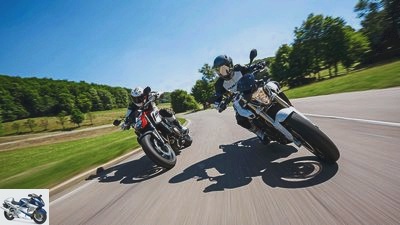
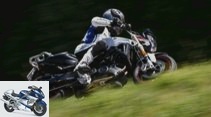

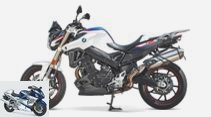
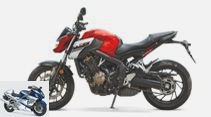
24 photos
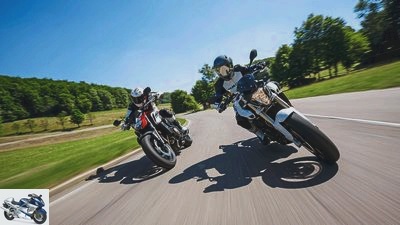
1/24
BMW F 800 R and Honda CB 650 F in comparison test.
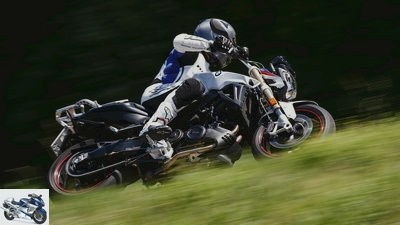
2/24
After the F 800 GS, the R is the longest-serving machine at BMW. The revised parallel twin still drives excellent.

3/24
BMW F 800 R and Honda CB 650 F in comparison test.
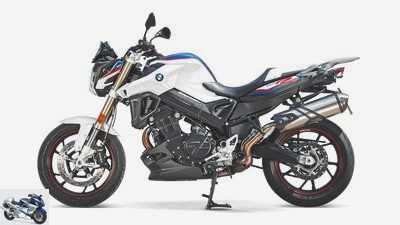
4/24
BMW F 800 R: middle class, big size. The F 800 R is a full-fledged, long motorcycle. 1523 millimeters wheelbase.
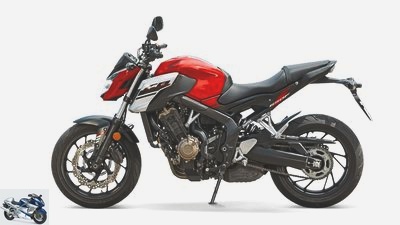
5/24
Honda CB 650 F: compact, stocky, wiry. A short 1450 millimeter wheelbase makes the 650 F a match.
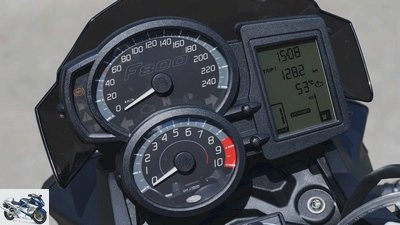
6/24
BMW F 800 R: It still exists, the speedometer as a round instrument! Expansive, tidy and clear, lots of information.

7/24
Honda CB 650 F: neither particularly beautiful nor particularly extensive, at least quite small. Not too strong a cockpit.
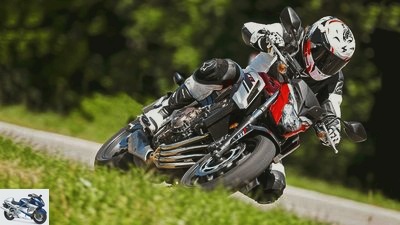
8/24
Honda CB 650 F: Technically, not much has changed, but the improvements in detail work. The new F looks much more dashing than before.
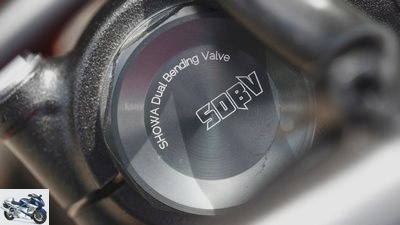
9/24
BMW F 800 R and Honda CB 650 F in comparison test.
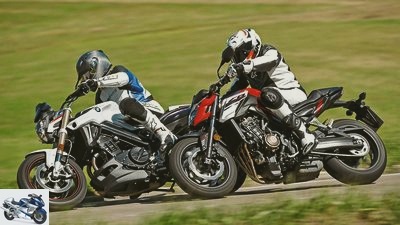
10/24
Driving fun, sometimes like this, sometimes like that: The BMW rolls neutral and stable, the Honda is fluffy and nimble. Both good.
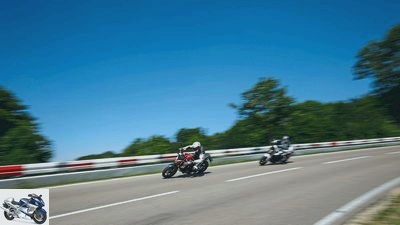
11/24
BMW F 800 R and Honda CB 650 F in comparison test.
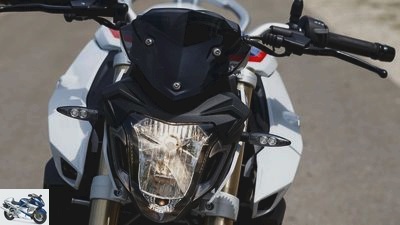
12/24
BMW F 800 R and Honda CB 650 F in comparison test.
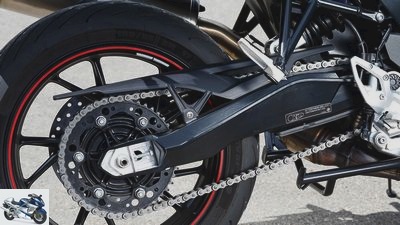
13/24
BMW F 800 R and Honda CB 650 F in comparison test.
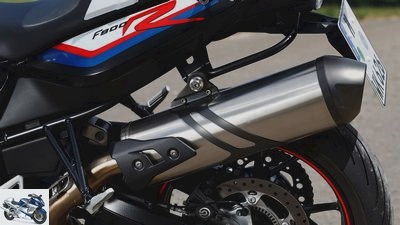
14/24
BMW F 800 R and Honda CB 650 F in comparison test.
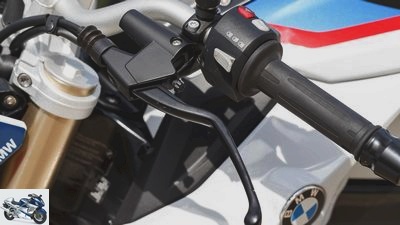
15/24
BMW F 800 R and Honda CB 650 F in comparison test.
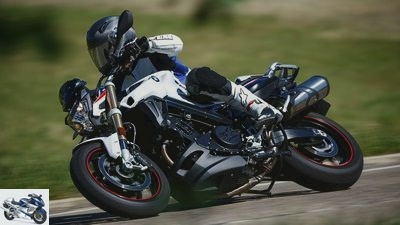
16/24
BMW F 800 R and Honda CB 650 F in comparison test.
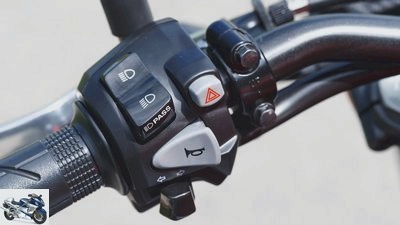
17/24
BMW F 800 R and Honda CB 650 F in comparison test.
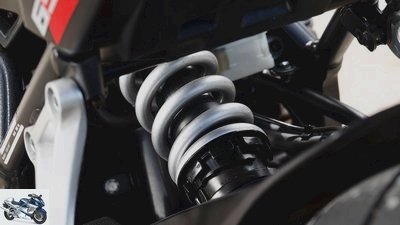
18/24
BMW F 800 R and Honda CB 650 F in comparison test.
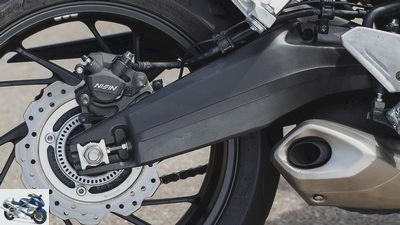
19/24
BMW F 800 R and Honda CB 650 F in comparison test.
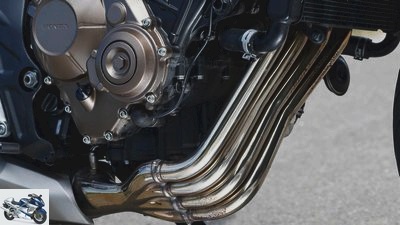
20/24
BMW F 800 R and Honda CB 650 F in comparison test.

21/24
BMW F 800 R and Honda CB 650 F in comparison test.
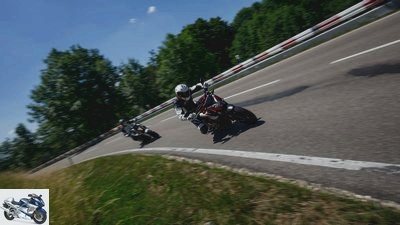
22/24
BMW F 800 R and Honda CB 650 F in comparison test.

jkuenstle.de
23/24
BMW F 800 R and Honda CB 650 F in comparison test.

24/24
BMW F 800 R and Honda CB 650 F in comparison test.
BMW F 800 R and Honda CB 650 F in the test
Middle class under 100 hp
The middle class has long left the 100 hp barrier behind. Is that a bit too much of a good thing for you? Then the BMW F 800 R and Honda CB 650 F with around 90 hp still offer a lot of cheeky fast-forward feeling.
Which class is currently the middle class? Is it the machines for 9,000 euros, like an MT-09, Street Triple S, GSX-S 750, as we compared them in MOTORRAD 12/2017? Well, with the arrival of the new, 125 hp Z 900 at the latest, this middle class has to be expanded to include the “upper” attribute. In the other middle class, the “lower”, there are bikes like the SV 650, Z 650 and MT-07 with around 75 HP for less than 7,000 euros. Between the two lies, if you will, the actual middle class. Around 90 hp, these machines have at least sufficient power, and since they are below 95 hp, they can also be moved in a reduced form by holders of the A2 driving license. Until the Aprilia Shiver 900 is available, the only representatives of the center-center Nakeds are: BMW F. 800 R and Honda CB 650 F.
Buy complete article
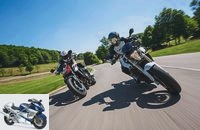
BMW F 800 R and Honda CB 650 F in the test
Middle class under 100 hp
CB 650 F means this first revision: fresh, extremely well-sharpened optics (new LED headlights and tank side panels), shorter gear ratio for gears two to five, “dual bending valve” technology for the fork. Thanks to the optimization of the intake and exhaust system, Honda promises a maximum output that has been increased by 4 to 91 hp. We will see.
In its basic design, the F 800 R has already had a few laps on the humped tank dummy. Born in 2009, the small Bayern roadster received a major update in 2014 with a USD fork, radial brake calipers and symmetrical headlights. The only new feature for 2017: E-gas and the associated driving modes “Road”, “Rain” and “Dynamic” (the latter optional extra). In general, letters to the editor can tip the pen here, the test motorcycle, lavishly equipped with dynamic, safety and touring packages, stretches the price range at 10,460 euros (base: 8,900 euros). What the heck, that’s exactly what the price-performance rating is for. For the Honda produced in Thailand, cheap 8100 euros are due.
Test procedure. It begins with the consumption drive, which allows man and machine to find one another in peace on a moderate country road. Both bikes welcome you with pleasant ergonomics. The CB 650 F offers an extremely compact arrangement of a short tank, a bench placed close to the handlebar, medium-high notches and a narrow, close knee joint. A touch of front-wheel-oriented sport, so full of energy. The BMW driver sits further back in a motorcycle that immediately looks longer, bigger – and is. On a long riser, a far cranked, higher handlebar stretches towards the driver, who has to fold his legs a little more due to higher, further forward footrests and subjectively deeper seat hollow (the seat height is the same at 800 millimeters, but the BMW dummy tank is significantly higher). This attitude is less active, but at least more relaxed. a matter of taste.
This pronounced difference in size (Honda wheelbase: 1450 millimeters, BMW 1526 millimeters) has a decisive influence on the subjective driving experience. Right from the start, the CB 650 F looks greedy and livelier when turning in, despite the identical ready-to-drive weight of 210 kilograms. Compact geometry achieves jagged handling. In contrast, the elongated BMW feels much calmer, more relaxed and less hungry at first – the seating position makes a significant contribution to this. But even at the first turn it reveals an impressive handiness, which is due to the first tires, the good Michelin Pilot Power 3. Its more pointed contour, its steeper flank, gives the F 800 R its legs in conjunction with its balanced geometry and perfect balance. Honda relies on a clearly flatter contoured Dunlop D 222 “M”, which rather inhibits the uncommonly bustling 650 F in its cornering vigor with increasing lean angle.
The mighty USD fork of the 800 R is superior to the conventional Honda counterpart, especially in terms of responsiveness. With a noticeably lower breakaway torque, it scans the asphalt more sensitively than the strangely bumpy CB fork. At the rear, the BMW has the electronic ESA suspension as an optional extra, which, in the simple version, adjusts the rebound stage according to the modes “Comfort”, “Normal” and “Sport”. The former spreads exactly the comfort that the name promises. The also directly hinged strut of the Honda works better than the fork, flawlessly for this price range – no more, but also no less.
In terms of engines, too, the BMW has so far been ahead. In the case of a low-rev, fluid driving style, the two-cylinder delivers a much more confident draft thanks to the powerful increase in displacement and larger individual combustion chambers. Acoustically, the synchronous runner with 360 degrees of ignition interval makes the boxer engine, spit unabashedly through the lower speed range. Euro 4 reluctance? Puff cake. The engine seems to have lost some of its well-known rattling, but it remains true to itself with robust vibrations in all areas – regardless of the idiosyncratic swiveling-connecting rod compensation mechanism. The CB 650 helps the shortened gear ratio, accurate throttle response and the silky smoothness of the quad deserve praise in the lower half of the speed. In addition to the beefy twin, the CB-Four looks flat. The smoother, better transmission is undoubtedly in the Honda, the BMW likes to produce loud knocks when downshifting.
The consumption round ends at the pump: cheap 4.3 liters gurgling into the tank of the 650 F after 100 kilometers, the BMW stashes very cheap 4.0 liters under the seat. Cable ties and a folding rule help to find out the inharmonious way the Honda telescopic fork works: the CB 650 F effectively uses 110 millimeters of spring travel, while the static unloaded spring travel is already 35 millimeters. With a 80-kilogram driver, the front sags further to 55 millimeters or 50 percent negative spring travel. Too much, the fork tends to work too close to end progression. Finding: For properly proportioned Western Europeans, the springs of the CB 650 F are somewhat soft, unfortunately preloading is not possible. No broken leg, the driving behavior remains satisfactory. But it could be done better. In view of this fact, it is difficult to assess to what extent the “Dual Bending Valve” system, of which Showa promises functionality similar to a more expensive cartridge insert, influences the damping behavior. But now to the handling section. No more consumption, on the shower!
Already powerful at the bottom, the Bayern twin flexes his biceps in the middle, then turns into the region of impressive driving performance. The direct, but still finely controllable “Dynamic” variant can now be used for mapping, in the ESA the sport mode is quickly zipped in, which significantly tightens the hindquarters, and at the push of a button turns the F 800 R into a serious milling machine. In addition, there is a brake that claims to be a reference on the ten-mille brand: one-piece Brembo four-piston calipers, radially screwed, and 320 double discs are in dire straits. Almost poisonous controllability, brutal effect – like a small K 1300 R. From a business point of view it is remarkable how this anchor made it to a mid-range bike. But not everything is perfect: With a rapid drive, the F 800 fork rustles softly and underdamped by the compression stage, allowing too much movement. The front then hardens over edges and divides. The beastly braking effect also reveals a lot of erection torque.
The CB 650 F can do that better, and in general it parries quite well in the event of an attack. Rather strolling downstairs, the four-in-a-row engine develops joie de vivre (and vibrations) in the upper half of the speed, and above five-digit speeds it becomes real glow. The screamer can be twirled up to almost 12,000 revolutions, almost catching up with the F 800 R here. Keeping the barrel organ singing is a feast across the country, especially since the unit roars out of the airbox in a manner that is informative but unpleasant compared to last year. A drive for lovers of the classic, freely rotating inline four.
On the chassis side, the CB 650 F is also capable of fun operation, the outlined enthusiasm when turning in is simply a stimulus, the brakes (two-piston floating calipers) need a little more manual force, but decelerates precisely and accurately, the ABS controls finely. Only the first tires do not keep up. In addition to the flat contour mentioned, the somewhat diffuse feedback is annoying, and the Michelin F 800 R also performs significantly better in terms of maximum grip. A higher-quality tire would be excellent for the CB 650 F, with a tighter front suspension (or a 55-kilo jockey in the saddle) the only real criticisms would be resolved. The fact that the BMW wins so high in the end can be explained primarily by the equipment, in addition to the noteworthy but not overwhelming advantages of the engine, chassis and brakes. Luggage rack, main stand, good on-board computer, gear indicator, adjustable levers, traction control, driving modes, enormous passenger comfort – some of them are subject to a surcharge (and recommendable), all of which are worthy of points, and not available at Honda ex works. So the price question is put into perspective – although 2300 euros more expensive, the BMW assembled in Spandau comes very close to the Thailand Honda in terms of price-performance. While the CB 650 F primarily aims to be a fun motorcycle, the F 800 R is convincing in all areas in terms of form and function – from the inside out.
MOTORCYCLE test result
1. BMW F 800 R
The not so small Bayern roadster surprised. Pressure, handling, awesome brake, but above all equipment and everyday skills unmatched in this class make it almost a bargain despite small weaknesses.
2. Honda CB 650 F
Less serious, more committed to absolute driving pleasure than chasing points. The speed-hungry engine is something for four-cylinder friends. The actually wonderful handling is slowed down a little by the poor initial tires.
Related articles
-
Naked bikes with four-cylinder engines in the test
Photos: 26 photos 1/26 Yes, slowly through the village is also possible. 2/26 The middle class is changing. Can they…
-
Honda NC 700 S and Yamaha XJ6 ABS in the test
17th photos 1/17 Honda NC 700 S and Yamaha XJ6 ABS in a 48 hp comparison test. 2/17 Honda NC 700 S and Yamaha XJ6…
-
Honda NC 700 X and BMW G 650 GS – entry-level motorcycles put to the test
11 photos 1/11 The Honda NC 700 X and BMW G 650 GS – two motorcycles in a comparison test that were built to match the 48 hp…
-
Honda CB 1100 RS, Kawasaki Z 900 RS and Yamaha XSR 900 in the test
bilski-fotografie.de 31 photos bilski-fotografie.de 1/31 The Honda CB 1100 RS. bilski-fotografie.de 2/31 A feast for the eyes: Visually, the Honda is…
-
BMW R nineT and BMW R 1200 R in the test
www. 39 Pictures www. 1/39 When the R 1200 R drives off, the eyes stay on the R nineT, if it rolls up, all eyes follow it. So…
-
Comparison test of disguised all-rounders
Gargalov comparison test disguised all-rounders But with a bowl, please Suzuki’s small Bandit series is a great success. But it doesn’t cover all …
-
Comparative test of naked bikes – reason machines
j.kuenstle.de 39 pictures 1/39 Suzuki B-King: Price 14,490 euros, additional costs around 145 euros. 2/39 Kawasaki Z 1000: Price 11295 …
-
Gargolov 31 pictures Gargolov 1/31 Gargolov 2/31 A positive impression: the stainless steel panel along the tank looks valuable and elegant, the tank cap …
-
MOTORCYCLE Supersport Test 2011: Race Track
82 pictures Kuenstle 1/82 Easy to use traction control of the Aprilia. Kuenstle 2/82 A thoroughbred racing file with incredible …
-
BMW G 310 R and Yamaha MT-03 in the test
25 pictures 1/25 BMW G 310 R and Yamaha MT-03 in the comparison test. 2/25 BMW G 310 R and Yamaha MT-03 in …